|
 |
|
page: 1 | 2 | 3 | 4 | 5 | 6 | 7 | 8 | 9
|
|
|
Behind the next hill we catch the first glance of the Torres del Paine. An amazing sight. The ice capped granite towers rise 3.000 meters above the pampa. Like in a bad movie a flock of Vicuñas is crossing the road. The weather is kind to us, the air is calm and the skies are bright. Around noon we reach the national park and find a nice spot on the campground below shady trees. In the evening the wind calms down completely and it starts raining, so next morning we are packing wet tents and start hiking around the Torres del Paine massif. The streams are swollen from the nightly rain, and Thomas can´t cross the second one and returns to the camp. So I carry on on my own to the Italian Camp through pouring rain. At night I dry my gear in the apsis and listen to the storm raging through the beech trees from my warm sleeping bag.
|
|
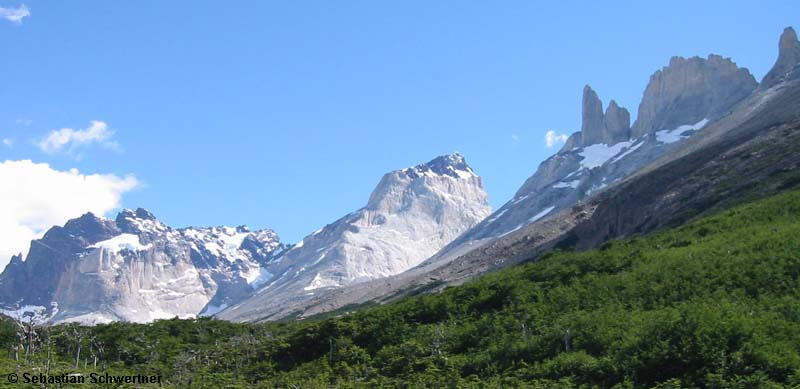 |
|
|
Valle des Frances
|
|
|
The next day I spend exploring Valle des Frances. The beech forest changes quickly into low bushes and above 1.000 meters only lichen and small grass patches remain. The tree line here depends on slope and wind exposition. At 1.800 meters I reach a small saddle behind the Paine Towers. The pass is snow covered, runs from west to east and is like a wind tunnel. Here the wind blows with 150 km/h and more. I´ve never experienced wind like this before. Standing up is impossible, I´m crawling on all fours and have to sit down to take pictures. I don´t spend much time up here, walk back to the camp and have another night in the fairytale forest, sleeping soundly even when the tent crackles wildly.
|
|
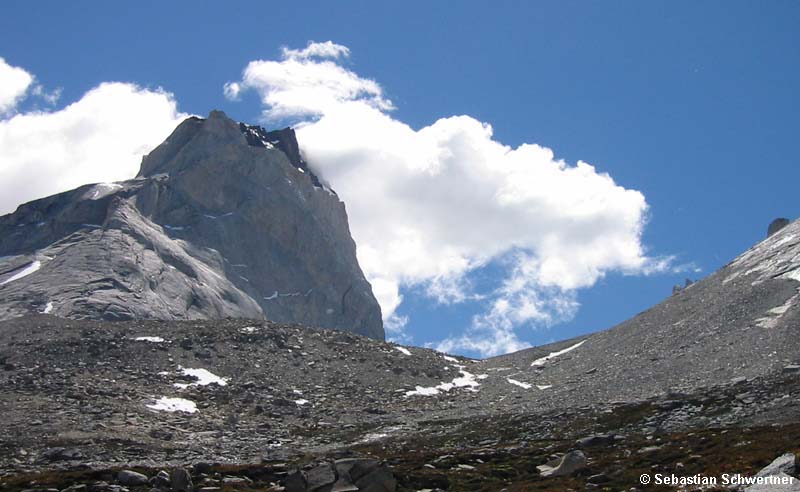 |
|
|
Paso del Viento
|
|
|
The next day starts grey and I just manage to pack my tent before it starts raining again. I want to reach Lake Grey today. The lake is fed by Grey Glacier, which is part of the southern Patagonian ice cap. At the lake shore is a nice hut with a good view. I spend the afternoon sipping hot chocolate, eating cakes and watching icebergs float by driven by the strong wind. It takes them about one hour to get from one end of the lake to the other. It has been snowing all night down to 800 meters above sea level. So I walk back and take a boot across Lake Pehoe. On the other shore a bus is waiting and takes me back to the Las Torres Camp and my bicycle. Here on the lee side of the mountain range the weather is much better. But there is still a strong wind blowing with a lot of föhn clouds on the sky.
|
|
|
|
|
|
Gaucho in Paine National Park
|
|
|
|
|
|
|
|
|
|
|
I use the last day in Paine National Park to have a look at the impressive towers from close by. From the campground this is a steep two-hour walk to the lookout point at a glacial lake. Early in the morning I have the view point almost to myself. On the way back more than 100 people are hiking uphill, but the next storm front is moving in fast. Back at the camp the wind has picked up even more, so I pack my tent and use the tailwind to cycle back to the hospedaje in Cerro Castillo.
|
|
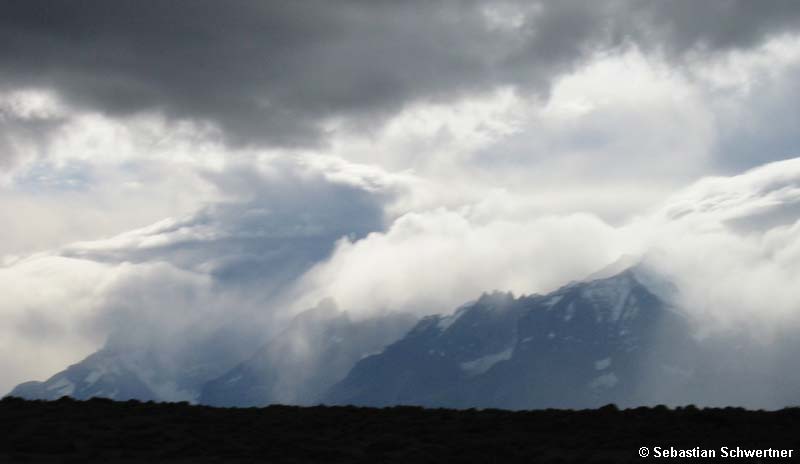 |
|
|
Storm over the Paine towers
|
|
|
Cerro Castillo is also the border crossing to Argentina. Between both posts are five kms of no man´s land. The procedure is fast and straightforward. My passport gets stamped twice, I have a quick chat with the border guards and 10 minutes later I´m off to Calafate. In Argentina the tracks are a lot worse than in Chile. On a short steep uphill I have to push my bike for 100 meters, the wind is still strong and the gravel is very soft. At night I´m very surprised to have managed 120 kms. I pitch the tent in a small dip next to the road. A German cyclist comes by while I´m cooking dinner. He bought a cheap bike in La Paz/Bolivia and has been cycling across Southern America for three months. His back wheel collapsed twice, he neither had panniers nor tools nor spare parts. He even asks to use my pump. But we have different valves.
|
|
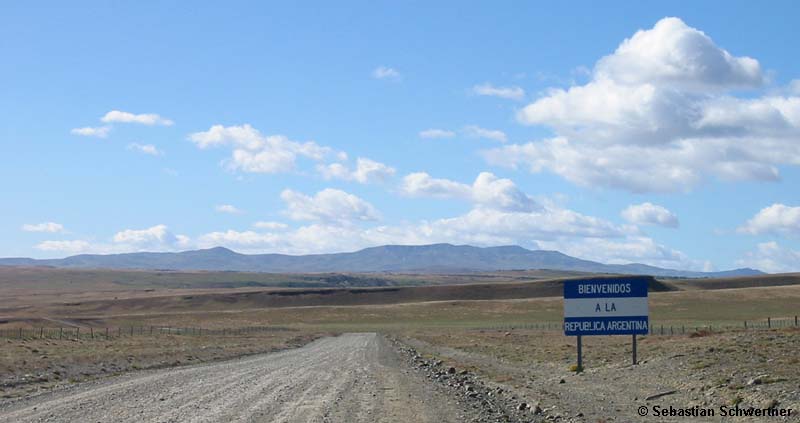 |
|
|
Pampa in Argentina
|
|
|
The tent spot is not very comfortable and the wind turns at night. When it starts raining I move into a big drainage pipe below the road. At 5 a.m. I´m back on the road. After three kms I reach the paved road from Calafate to the coast. And have to turn left into the wind. One hour later I´ve managed just six km against the storm. Frustrated I turn around and do 45 kms south east to the Atlantic Ocean, where I don´t want to go.
|
|
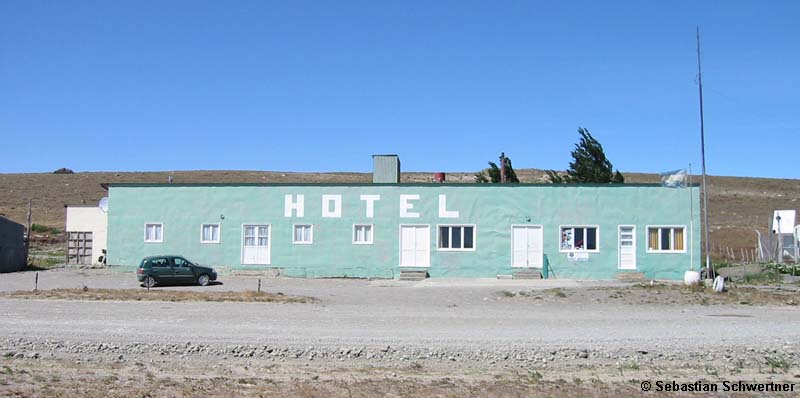 |
|
|
Hotel on the road
|
|
| Finally a mini bus stops and gives me a lift to Calafate. Two hours later I´m in the city, which is behind a big hill sheltered from the wind. The hostal used to be a police barracks and has small rooms with four bunk beds. But my first stop is one of the many bakeries with good cakes and hot chocolates. A diesel generator is in the middle of town otherwise this could be a Spanish city somewhere in the Pyrenees with posh outdoor stores, cafés and travel agencies, that offer trips to the Perito Moreno Glacier and El Chalten.
|
|
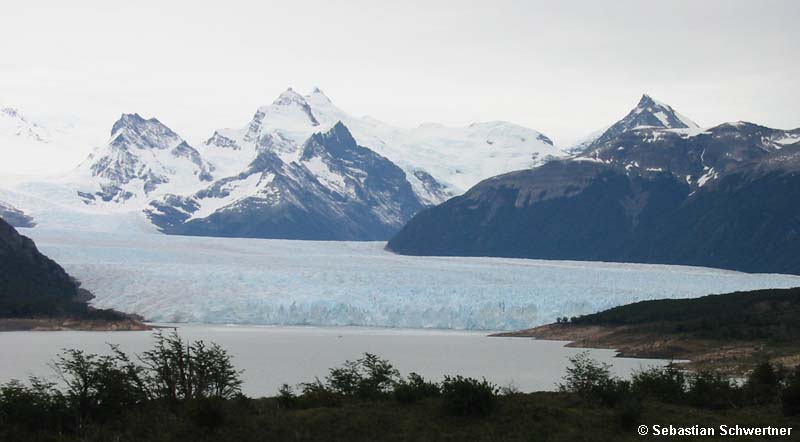 |
|
|
Perito Moreno glacier
|
|
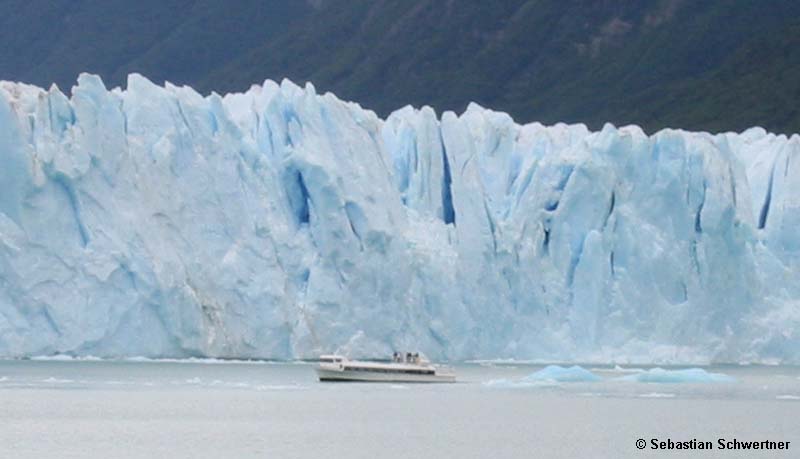 |
|
|
Glacier front
|
|
|
Next morning I join the youth hostel´s tour to the Perito Moreno Glacier, which is led by a geologist. The glacier is part of the Southern Patagonian Ice Cap and has a 50 m tall front into Lake Argentino. During summer days there is constant activity with small and bigger blocks falling from the glacier front into the lake. We see a house-sized block fall into the lake and create a big wave. I only realise the sheer size when one of the tourist boats is going by. The glacier front is moving back and forth a couple of meters every year. In 2003 only a few meters were missing to block the upper part of the lake, which happens every four to ten years. Then the water level rises 15 meters within a couple of days before the pressure of the water gets so strong that the glacier front breaks below the weight of the water. At the lookout I meet Thomas, who came here on a day trip from Puerto Natales. We hope to meet again on Carretera Austral in two weeks.
The wind is still strong when I leave El Calafate the next morning. I opt for the bus and my bicycle is tied to the roof. But after only 10 kms the bus breaks down with gear box problems. Two hours later an even older spare bus arrives. The landscape is stunning. To the east are the rolling green hills of the Pampa, to the west are the craggy peaks of the Andes and blue glacial lakes.
|
|
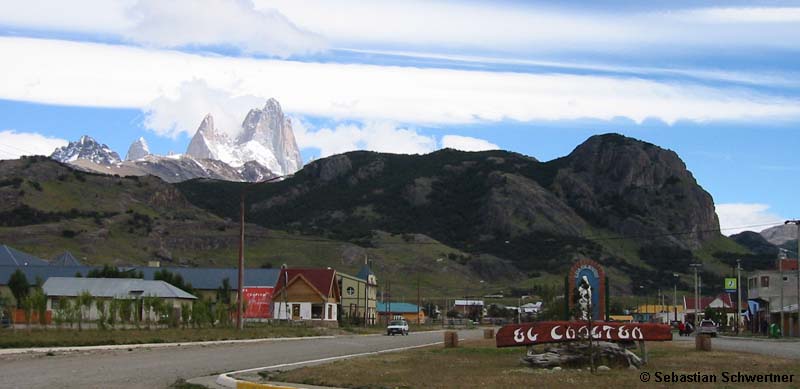 |
|
|
El Chalten
|
|
|
Until 1990 El Chalten was a small village in the middle of nowhere. But now it´s filled with tourists. The devaluation of the Argentinian Peso since 1980 made travelling abroad for most Argentinians too expensive. But the village has kept some of its wild-west charme. During the high season it is impossible to get a hotel room in town without booking in advance. So I walk two hours up to Camp Bridwell, the starting point to climb Cerro Torre. Here is a small cluster of tents with a warped hut in the middle below low beech trees. The interior and the wood carvings show signs of long waiting periods for better weather. Today Cerro Torre is hidden by thick clouds. And the summit is graced by long veils of snowdrift.
|
|
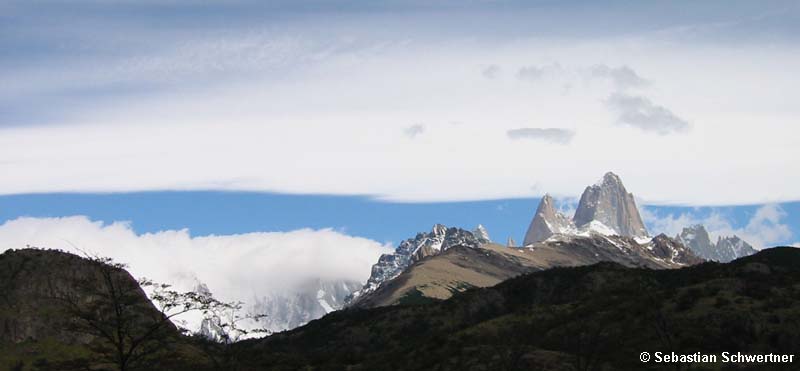 |
|
|
Fitz Roy and Cerro Torre hidden by clouds
|
|
|
|
The storm rages through the forest all night and it rains just as much. But that doesn´t stop me from sleeping sound. On the next morning the sun is shining and I walk together with an American to the left-hand side of the large moraine above Lake Torre to the glacier at the base of Cerro Torre. Only the view of the summit is obscured by clouds all day long. I spend the next day walking around the park and enjoy the amazing views of Fitz Roy whose summit is in bright sunlight.
|
|
|
page: 1 | 2 | 3 | 4 | 5 | 6 | 7 | 8 | 9
|
|

